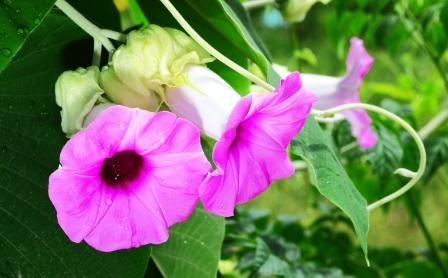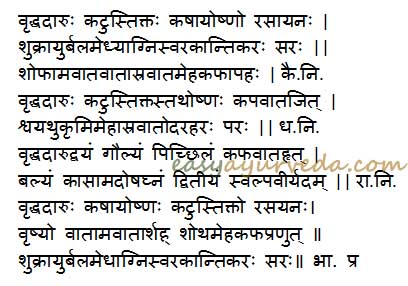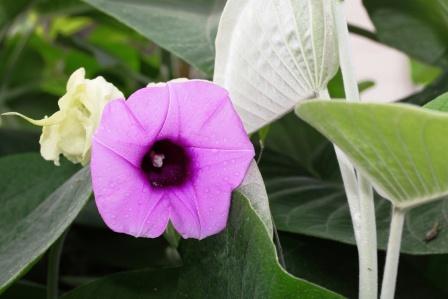Vruddhadaru Argyreia speciosa: Uses, Remedies, Research
By Dr BK Prashanth MD (Ayu), PhD (Ayu)
Vruddhadaru- Argyreia speciosa is a plant mentioned for the treatment of swelling, rheumatoid arthritis, general debility, leucorrhea, oligospermia and diabetes.
Latin name- Argyreia speciosa Sweet. Some identify Argyreia nervosa as Vridha Daru.
Family- Convolvulaceae (Trivrit kula)
English name – Elephant Creeper
Table of Contents
Uses, Indications
- The leaf of Argyreia speciosa is slightly heated and applied over wounds associated with pus for quicker ripening of the wound and proper healing.
- The powder of the root is given in a dose of 3-5 g to treat oligospermia.
- The cold infusion or the decoction of the plant is given in a dose of 40-5o ml to control diabetes.
- The decoction of the root of Argyreia speciosa is useful to treat leucorrhea and fever.
- The powder of the root is given with honey to treat cough and improve the voice.
- The powder of the seed is given in a dose of 2-3 g to treat insomnia.
- The decoction of Vruddhadaru is given in doses of 30-40 ml to treat nerve weakness and improve the strength of the cardiac muscles.
- The juice of the leaf is used to treat indigestion, lack of appetite and constipation.
- Ghee cooked with vruddhadaru root should be taken with milk. It is an excellent aphrodisiac and should be usually those desiring progeny.
Traditional uses:
Rasayana – anti aging, causes cell and tissue rejuvenation
Shukrakara – improves sperm and semen quality, quantity
Ayukara – improves life expectancy
Balakara – improves strength and immunity
Medhya – improves intelligence
Agnikara – improves digestion strength
Swarakara – improves voice tone and quality
Kantikara – improves skin complexion
Sara – induces mobility, causes diarrhea, purgation, relieves constipation
Indicated in:
Shopha – inflammation
Amavata – Rheumatoid arthritis
Vatasra – Gout
Vatodara – Bloating

Properties, part used, dosage
Elephant creeper Qualities and benefits:
Bhavaprakasha text explains it as a drug possessing bitter-pungent and astringent taste.
It is considered to be a drug of hot potency.
The roots are aphrodisiacs as well as rejuvenating.
It is widely used in treating neuromuscular disorders, hemorrhoids, inflammatory conditions, urinary disorders etc. The regular usage of the root and stem is considered to improve voice and skin complexion.
Controversy:
Few authors consider Ipomea biloba Forsk, Ipomea petaloidea Chois etc as Vriddhadaru.
However as they possess similar properties, in the absence of one another can be used in medicinal practices.
Read related: Vruddhadaru Argyreia speciosa: Uses, Remedies, Research
Properties of Vidhara (Yuvika Bidhara)
Rasa (Taste) – Katu (Pungent), Tikta (Bitter), Kashaya (Astringent)
Guna (Qualities) – Laghu (Light for digestion), Snigdha (Slimy)
Vipaka – Madhura (Undergoes sweet taste after digestion)
Veerya (Potency) – Ushna (Hot)
Karma (Actions) – Kaphavata shamaka (reduces vitiated kapha and vata dosha)|
Pharmacological action- Antidiabetic, Anti microbial, Diuretic, Hypotensive, Spasmolytic, Aphrodisiac,
Part used- Root, Seed powder
Dosage- 3 to 6 g of root powder, 1 to 2 g of seed powder
According to Bhojana Kutuhalam twelfth chapter, both the varieties of vruddhadaru are sweet, slimy and balance kapha and vata. It is strengthened in nature, treats cough and ama dosha and one of them reduces virility.
Home remedies
By Dr MS Krishnamurthy MD(Ayu), PhD
Few of the simple and effective remedies:
Arthritis, joint pain
Root decoction in arthritis and joint pain:
The mature roots are collected and dried. 10-15 grams of the root powder (coarse) is taken and made into decoction. This decoction is administered in the dose of 30-40 ml, twice daily. This is found to be very effective in acute and chronic body pain, arthritis, aching pain etc.
General method of making decoction is – 1 tablespoon of coarse powder of herb is added with a cup of water, boiled and reduced to half a cup, filtered and consumed when still hot.
Gynaecological disorders
Fine powder of Vriddhadaru and Lodhra and Ashoka in gynecological disorders:
The drugs Vriddhadaru, Lodhra (Symplocos racemosa) and Ashoka (Saraca asoka) are taken in equal amounts and fine powder is made.
5 grams of this powder is mixed with equal amounts of ghee and sugar candy and administered.
This is useful in Menorrhagia (heavy periods) and leucorrhea. This remedy can be continued for 1 week.
Headache, pedal edema
Fine paste of leaves in headache and pedal edema:
Mature green leaves are taken and fine paste is made (little tamarind leaves can also be added). This paste is warmed a little and applied over the forehead. This relieves acute headache. In pedal edema also its fine paste is applied over the foreleg and foot.
Read related: Pedal Edema: Feet Swelling Causes, Differential Diagnosis, Symptoms
Emaciation, loss of libido
Medicated milk in emaciation and loss of sexual libido:
This is a common practice in West Bengal and Kerala. The medicated milk of the roots is taken to improve the sexual vigor and to get good body strength and to increase the bulk of the muscles.
People take many multivitamins, nutritional supplements, minerals and trace elements to keep cells healthy for a long time. In Ayurveda, we use herbs such as Vriddhadaru for the same purpose.
Click to consult Dr MS Krishnamurthy MD(Ayu), PhD
Morphology
Morphology of Argyreia speciosa: The plant is a perennial climbing vine and is native to Indian sub- continent and later introduced through- out the world. Hairs like small structures are seen over the stem of the plant. The leaves are wide, big and smooth at the top surface and have thin hair-like structure on the lower surface. The flowers are bell shaped and purple to pink colored. The seeds of the plant are pale white and intoxicating in nature.
Chemical constituents
Chemical constituents of Argyreia speciosa
The plant contains tannins and resin. The roots yielded and resins of amber color, soluble in either and benzole and partly soluble in alkaloids. The seeds are reported to contain alkaloids, chanoclavine, ergine, ergonovime and isoergine. The extract of seeds exhibits hypotensive and hallucinating activity. The leaf contains 1-triacont and epifredelinol and its acetate and β-sitosterol.
Sanskrit verse

Adverse effects
The dried seeds are intoxicating and can cause hallucination and inebriated condition. Due to this reason the seeds are banned in some European countries.
Interaction with medicines, supplements
Can this be used while taking Homeopathic medicine?
Yes. This product does not react with homeopathic medicine.
Can this medicine be continued while taking supplements like multivitamin tablets, Omega 3 fatty acids etc?
Yes. Generally, this product goes well with most dietary supplements. However, if you are taking more than one product per day, please consult your doctor for an opinion.
With western
medicines
Seek your
doctor’s advice if you are taking this product along with other western
(allopathic / modern) medicines. Some Ayurvedic herbs can interact with modern
medicine.
If both Ayurvedic and allopathic medicines are advised together, then it is
best to take Allopathic medicine first, wait for 30 minutes and then take the
Ayurvedic medicine.
Ayurvedic medicines
Formulations containing Vruddhadaru:
Bahusala guda – Arsas, Rajayakshma
Laxmivilasa rasa – Kasa, Swasa
Vriddhadaraka sama churna – Slipada, Amavata
Banovit capsule: It is a proprietary Ayurvedic medicine to regain loss of vigor, vitality and libido, and also it is a natural aphrodisiac.
Confido tablet: Confido Tablet is a proprietary Ayurvedic medicine. Confido increases sperm count and testosterone levels, thereby combating erectile dysfunctions. It regulates ejaculation via the neuroendocrine route and improves sexual drives.

Research
Research articles related to Argyreia speciosa:
Anti- anxiety activity: Aim of the present study was a comparative evaluation of antianxiety activity of three traditionally used medicinal plants — Argyreia speciosa (Roots), Caesalpinia digyna (Roots) and Sphaeranthus indicus (Flowers). The activity of various extracts (petroleum ether, chloroform, ethanol and water) of all the three plants was evaluated using an elevated plus-maze model. The studies were conducted on lacca mice, and the test materials were administered per oral route. Results indicate that the ethanol extract of C. digyna roots exhibited maximum and significant dose dependent effect at 200 and 400 mg/kg on elevated plus-maze, the results were comparable to the standard antianxiety drug diazepam (2 mg/kg).
Anti- inflammatory action: The study was carried out using male albino mice (20-25 gm) and male wistar rats (100-150 gm). The ME was prepared using a soxhlet extraction process. The effect of ME of A. speciosa was investigated for analgesic activity using acetic acid-induced abdominal constriction, tail immersion method and hot plate method. The anti-inflammatory activity of ME of AS roots was studied using carrageenan-induced rat paw edema. The ME of A. speciosa showed significant analgesic and anti-inflammatory activity in mice and rats.
Wound healing property: In order to find scientific evidence for the traditional utilization of leaves of A. speciosa in wound healing, this investigation was carried out. A simple ointment, developed by including ethanol, ethanol-water, and water extracts (10% each, separately) of A. speciosa, was applied topically to mice once daily for 14 days after wounding. The water extract of A. speciosa showed accelerated wound healing activity as evidenced by fast wound contraction, rapid epithelization period, greater wound breaking strength, and higher hydroxyproline content of granulation tissue. The present report supports the traditional use of Argyreia speciosa leaves for wound healing and signifies its relevant therapeutic potential.
Classical categorization
Charaka: Sukrajanana
Sushruta: Adhobhagahara
Bhavaprakash Nighantu: Guduchyal varga
Dhanwantri Nighantu: Karaveeradi varga
Bhavaprakash Nighantu: Guduchyadi varga
Raja Nighantu: Guduchyadi varga
Nighantu Adarsh: Vriddhadarukadi varga
Scientific classification
Kingdom: : Plantae
Sub-kingdom : Phanerogamia
Division : Angiodpermia
Class : Dicotyledons
Subclass : Corolli florae /Gamopetpue
Order : Natural
Family : Convolulaceae
Genus : Argyeria
Species : Speciosa
Vernacular names
VriddhaDaru Names in different languages:
Hindi name: Samudrashosh, Bidara, Vidhara, Yuvika Bidhara
English name: Elephant creeper
Bengali name: Bichtarak Guguli
Gujarathi name: Samundar sosh
Kannada name: Samnudra balli
Malayalam name: Samudrapacha
Marathi name: Samudrasoah
Tamil name: Ambagar
Telugu name: Samudrapela
Sanskrit synonyms
Vridd daru Sanskrit Synonyms:
Trikonakanda- the stem of the vine is triangular
Hasthi valli- The leaf is big like the palm
Samudra patra- The leaf resembles the foam in sea waves when viewed from a distance
Ajaantri, Mahashyma, Vallari, Deergha, Samudra palaka, Avegi, Jongaka, Jirnavalaka,
Antakotarapushpi – flower with a hollow inside
Mahishavallari, Ajantri, Mahashyama, Vellari, Deerghavalaka, Jeernadaru
Author:
Dr.B.K.Prashanth M.D (Ayu), Ph.D
Click to consult Dr BK Prashanth
Systemic Action
External use
wound cleansing and healing. For wound healing purposes; the back side of the leaves is tied on wounds.
Internal administration-
Nervous system – Nerve tonic, promote intellect. Indicated in neuromuscular disorders.
Digestive System – Carminative, remove toxic materials from the body, facilitate proper movement of doshas, purgative. It indicates loss of appetite, constipation, Hemorrhoids, Ama dosha etc.
Respiratory system – Indicated in cough, hoarseness of voice etc.
Circulatory system – cardiac tonic. indicated in edema.
Reproductive system – Aphrodisiac, Indicated in inflammatory conditions associated with female reproductive system, leukorrhea etc.
Excretory system – Indicated in Diabetes.
Satmikarana – Rejuvenative. indicated in general debility, body weakness etc.










